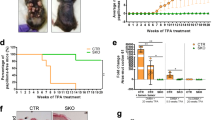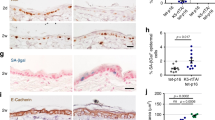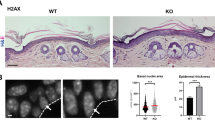Abstract
The mouse skin tumour promoter phorbol-12-myristate-13-acetate (PMA) does not form covalent adducts with cellular DNA and its mutagenic potency in several systems is low or absent1–6. There have been conflicting reports of the capacity of PMA to produce sister chromatid exchanges (SCEs)3,6–8. As PMA induces the formation of superoxide radicals in polymorphonuclear leukocytes and mitogen-stimulated lymphocytes9–11, we suggested that it might produce DNA damage via indirect action by the formation of intermediate active oxygen species12,13. As is typical for other DNA-damaging agents which mainly act indirectly, for example, ionizing radiation, PMA would be expected to have low mutagenicity but high clastogenic (chromosome-breaking) activity14. In agreement with this, we report here that PMA, but not its weakly or non-promoting derivatives, induced chromosomal aberrations with high efficiency in phytohaemagglutinin (PHA)-stimulated human lymphocytes, but was only a weak producer of SCE. This activity was suppressed by superoxide dismutase, which catalyses the breakdown of superoxide radicals.
This is a preview of subscription content, access via your institution
Access options
Subscribe to this journal
Receive 51 print issues and online access
$199.00 per year
only $3.90 per issue
Buy this article
- Purchase on Springer Link
- Instant access to full article PDF
Prices may be subject to local taxes which are calculated during checkout
Similar content being viewed by others
References
Carcinogenesis Vol. 2 (eds Slaga, T., Sivak, A. & Boutwell, R.) (Raven, New York, 1978).
Diamond, L., O'Brien, G. & Baird, W. Adv. Cancer Res. 32, 1–74 (1980).
Kinsella, A. & Radman, M. Proc. natn. Acad. Sci. U.S.A. 75, 6149–6153 (1978).
Lankas, G., Baxter, C. & Christian, R. Mutat. Res. 45, 153–156 (1977).
Trosko, J., Chang, C., Yotti, L. & Chu, E. Cancer Res. 37, 188–193 (1977).
Thompson, L., Baker, R., Carrano, A. & Brookman, K. Cancer Res. 40, 3245–3251 (1980).
Nagasawa, H. & Little, J. Proc. natn. Acad. Sci. U.S.A. 76, 1943–1947 (1979).
Loveday, K. & Latt, S. Mutat. Res. 67, 343–348 (1979).
De Chatelet, L., Shirley, P. & Johnston, R. Blood 47, 545–554 (1976).
Goldstein, B., Witz, G., Amoruso, M. & Troll, W. Biochem. biophys. Res. Commun. 88, 854–860 (1979).
Mueller, G., Wertz, P., Kwong, C., Anderson, K. & Wrighton, J. in Carcinogenesis: Fundamental Mechanisms and Environmental Effects (eds Pullman, B., Ts'o, P. & Gelboin, H.) 319–333 (Reidel, Holland, 1980).
Cerutti, P. & Remsen, F. in DNA Repair Processes: Cellular Senescence and Somatic Cell Genetics (eds Nichols, W. & Murphy, D.) 147–166 (Symposia Specialists, Miami, 1977).
Cerutti, P. in DNA Repair Mechanisms (eds Hanawalt, P., Friedberg, E. & Fox, C.) 717–722 (Academic, New York, 1978).
Kao, F. & Puck, T. J. Cell Physiol. 74, 245–258 (1969).
Nichols, W. in The Cell Nucleus Vol. 2 (ed. Bush, H.) 437–458 (Academic, New York, 1974).
Sperling, K. & Rao, P. Hum. Genet. 23, 235–258 (1974).
Ole, G., Lindecke, J., Waldenmaier, K. & Sperling, K. Hum. Genet. 28, 159–162 (1978).
zur Hausen, H., O'Neill, F., Freese, U. & Hecker, E. Nature 272, 373–375 (1978).
Wolff, S. & Perry, P. Chromosoma (Berl.) 48, 342–358 (1974).
Emerit, I. & Cerutti, P. Proc. natn. Acad. Sci. U.S.A. 78, 1868–1872 (1981).
Crossen, P. E. & Morgan, W. F. Expl Cell Res. 104, 453–457 (1977).
Keck, M. & Emerit, I. Hum. Genet. 50, 277–283 (1979).
Emerit, I. Z. Rheumaforsch. 39, 84–90 (1980).
zur Hausen, H., Bornkamm, G., Schmidt, R. & Hecker, F. Proc. natn. Acad. Sci. U.S.A. 76, 782–785 (1979).
Arya, S. Nature 284, 71–74 (1980).
Fisher, P., Weinstein, I., Eisenberg, D. & Ginsberg, H. Proc. natn. Acad. Sci. U.S.A. 75, 2311–2314 (1978).
Yamamoto, N. & zur Hausen, H. Nature 280, 244–245 (1979).
Monier, R., Daya-Grosjean, L. & Sarasin, A. in Carcinogenesis: Fundamental Mechanisms and Environmental Effects (eds Pullman, B., Ts'o, P. & Gelboin, H.) 371–378 (Reidel, Holland, 1980).
Author information
Authors and Affiliations
Rights and permissions
About this article
Cite this article
Emerit, I., Cerutti, P. Tumour promoter phorbol-12-myristate-13-acetate induces chromosomal damage via indirect action. Nature 293, 144–146 (1981). https://doi.org/10.1038/293144a0
Received:
Accepted:
Issue Date:
DOI: https://doi.org/10.1038/293144a0
This article is cited by
-
Factor-specific generative pattern from large-scale drug-induced gene expression profile
Scientific Reports (2023)
-
Priming stem cells with protein kinase C activator enhances early stem cell-chondrocyte interaction by increasing adhesion molecules
Biological Research (2018)
-
Mechanism of inhibition of Shiga-toxigenic Escherichia coli SubAB cytotoxicity by steroids and diacylglycerol analogues
Cell Death Discovery (2018)
-
Clustergrammer, a web-based heatmap visualization and analysis tool for high-dimensional biological data
Scientific Data (2017)
-
Acetylcholinesterase Conformational States Influence Nitric Oxide Mobilization in the Erythrocyte
The Journal of Membrane Biology (2015)
Comments
By submitting a comment you agree to abide by our Terms and Community Guidelines. If you find something abusive or that does not comply with our terms or guidelines please flag it as inappropriate.



